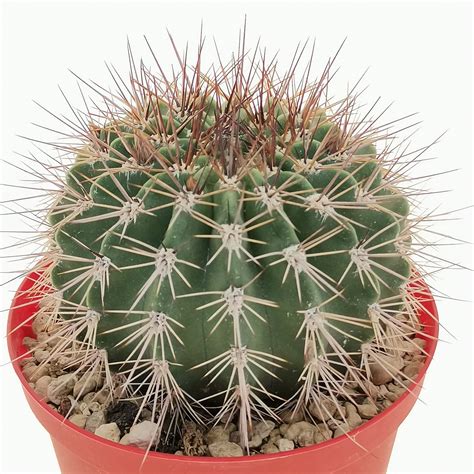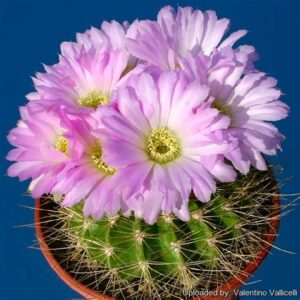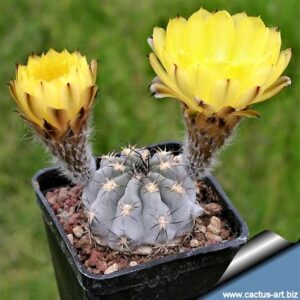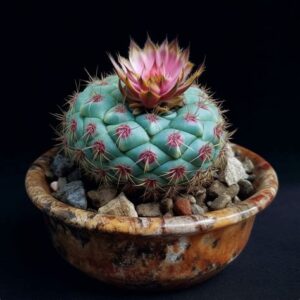When venturing into the world of cacti, one cannot overlook the mesmerizing Acanthocalycium peitscherianum. This enchanting species, belonging to the family Cactaceae, captivates enthusiasts with its striking aesthetics and intriguing growing habits. Whether you are a seasoned collector or a novice, understanding the nuances of this distinguished cactus is essential for successful cultivation and appreciation.
A Glimpse into the Origin
The Acanthocalycium peitscherianum hails from the arid regions of Argentina, where it flourishes in meager soil conditions amidst rocky outcrops. Its native habitat is characterized by a dry, warm climate, creating an environment that demands resilience and adaptability. This cactus is commonly found at elevations ranging from 800 to 1,300 meters, which contributes to its unique physiological traits. Each specimen manifests a form blending beauty and survival, an evolutionary testimony to its lineage.
Physical Characteristics: Nature’s Artwork
Diving deeper into the morphology of the Acanthocalycium peitscherianum, one can discern its defining features. This cactus typically presents a cylindrical or globular form, reaching an approximate height of 15 to 30 cm and a diameter of 8 to 12 cm. The surface is adorned with pronounced tubercles, giving it a textured appearance that is both rugged and captivating. The ribs of the cactus are prominent, defining its outline and enhancing its architectural allure.
Furthermore, this species displays a stunning array of spines. These spines range from 1.5 to 5 cm in length and exhibit shades of white to golden yellow, contrasting beautifully against the rich green body of the cactus. The arrangement of spines not only serves as a protective measure against herbivores but also contributes to the plant’s unique aesthetic appeal. When in bloom, the Acanthocalycium peitscherianum dazzles with flowers that are typically a striking bright yellow, occasionally exhibiting hues of orange or red, providing an enchanting spectacle in contrast to its formidable exterior.
Growing Conditions: A Guide for Cultivators
Providing optimal conditions is paramount to ensuring the health and vitality of your Acanthocalycium peitscherianum. This cactus thrives in well-draining soil, preferably a specialized cactus mix that allows for sufficient aeration. A mixture combining coarse sand, perlite, and organic matter works splendidly. The pH level of the soil should ideally range from 6.0 to 7.0, maintaining a slightly acidic to neutral state.
Light exposure is another critical aspect. Acanthocalycium peitscherianum favors bright, indirect sunlight. A south-facing window can provide the ideal light conditions; however, direct exposure in the peak hours can scorch its delicate skin. A balance of light is essential for optimizing growth and flowering, as insufficient light can lead to etiolation, causing the cactus to stretch unnaturally.
Watering practices are equally important. This species requires infrequent watering, particularly during the cooler months when its growth slows down. A thorough soak, followed by complete drying of the soil before the next watering, preferably in the growing season (spring and summer), is advisable. Overwatering can lead to root rot, a common pitfall in cactus care.
Propagation Techniques: Expanding Your Collection
For cactus enthusiasts eager to cultivate new specimens, understanding propagation techniques is essential. The Acanthocalycium peitscherianum can be propagated through seed germination or offsets, offering two fascinating pathways to expand your collection.
Seed propagation requires patience and precise conditions. Begin with fresh seeds, as viability decreases over time. Sowing seeds in a sterile, well-draining medium enables the creation of a conducive environment for sprouting. The seeds should be lightly covered with soil and kept minimally moist, while maintaining a warm temperature to encourage germination. Ideally, a seedling heat mat can be instrumental for achieving optimal warmth. Expect germination to occur within two to four weeks with proper care.
Alternatively, the propagation of offsets, commonly referred to as “pups,” presents a more immediate option. These small clones can be gently removed from the mother plant once they have developed sufficient roots. The pups should be left to callous over a few days before planting them in their own pots, ensuring a successful transplant.
Pest Management: Safeguarding Your Cactus
Even resilient cacti face threats from pests. Regular inspection of your Acanthocalycium peitscherianum is advised to detect any signs of infestations early. Common pests include mealybugs, spider mites, and scale insects. Employing a mix of neem oil and water for a gentle spray can effectively deter these invaders. Additionally, physical removal using a cotton swab dipped in alcohol can address minor infestations.
To maintain overall plant health, ensure that your growing area has good air circulation. Avoid overcrowding your collection, which can create a humid environment conducive to pest proliferation and fungal diseases.
Designing a Cactus Display: Creating a Captivating Environment
Integrating Acanthocalycium peitscherianum into your indoor or outdoor displays can enhance the aesthetic charm of your space. Due to its stunning floral displays and unique form, this cactus can serve as a focal point or a compatible companion to other succulent species within a themed garden. Pair it with contrasting shapes and colors, such as the soft, rosette forms of Echeveria or the robust nature of Agave, to create an intriguing tableau.
In containers, consider using decorative pots that accentuate the plant’s visual appeal. Terracotta, ceramic, or even concrete pots not only provide excellent drainage but can also serve as stylish décor. Including gravel or decorative stones atop the soil can reinforce the arid landscape while preventing unwanted weed growth.
Conclusion: The Allure of Acanthocalycium Peitscherianum
The Acanthocalycium peitscherianum is more than just a striking specimen; it represents resilience, beauty, and a profound connection to its native arid environment. With proper care and attention, this cactus can thrive, producing an array of captivating blooms that can mesmerize any observer. Whether you are enriching your collection or exploring new propagation avenues, this species promises to enhance your gardening experience. Embrace the journey of cultivating this remarkable cactus and celebrate its vibrant contributions to your botanical haven.





Leave a Comment